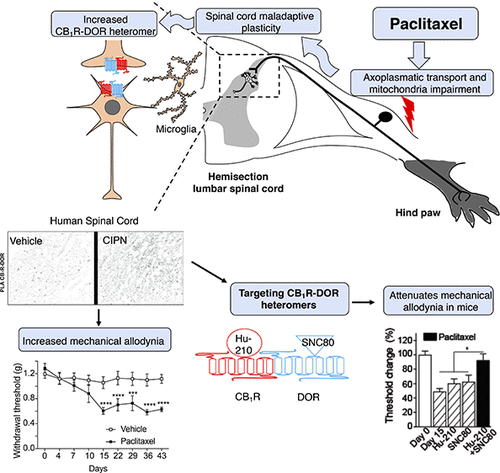当前位置:
X-MOL 学术
›
ACS Pharmacol. Transl. Sci.
›
论文详情
Our official English website, www.x-mol.net, welcomes your
feedback! (Note: you will need to create a separate account there.)
Targeting Cannabinoid 1 and Delta Opioid Receptor Heteromers Alleviates Chemotherapy-Induced Neuropathic Pain
ACS Pharmacology & Translational Science ( IF 4.9 ) Pub Date : 2019-06-14 , DOI: 10.1021/acsptsci.9b00008 Salvador Sierra 1 , Achla Gupta 1 , Ivone Gomes 1 , Mary Fowkes 2 , Akila Ram 3 , Erin N Bobeck 3 , Lakshmi A Devi 1
ACS Pharmacology & Translational Science ( IF 4.9 ) Pub Date : 2019-06-14 , DOI: 10.1021/acsptsci.9b00008 Salvador Sierra 1 , Achla Gupta 1 , Ivone Gomes 1 , Mary Fowkes 2 , Akila Ram 3 , Erin N Bobeck 3 , Lakshmi A Devi 1
Affiliation

|
Cannabinoid 1 (CB1R) and delta opioid receptors (DOR) associate to form heteromers that exhibit distinct pharmacological properties. Not much is known about CB1R-DOR heteromer location or signaling along the pain circuit in either animal models or patients with chemotherapy-induced peripheral neuropathy (CIPN). Here, we use paclitaxel to induce CIPN in mice and confirm the development of mechanical allodynia. Under these conditions, we find significant increases in CB1R-DOR heteromers in the dorsal spinal cord of mice with CIPN as well as in postmortem spinal cords from human subjects with CIPN compared to controls. Next, we investigated receptor signaling in spinal cords of mice with CIPN and found that treatment with a combination of low signaling doses of CB1R and DOR ligands leads to significant enhancement in G-protein activity that could be selectively blocked by the CB1R-DOR antibody. Consistent with this, administration of subthreshold doses of a combination of ligands (CB1R agonist, Hu-210, and DOR agonist, SNC80) leads to significant attenuation of allodynia in mice with CIPN that is not seen with the administration of individual ligands, and this could be blocked by the CB1R-DOR antibody. Together, these results imply that CB1R-DOR heteromers upregulated during CIPN-associated mechanical allodynia could serve as a potential target for treatment of neuropathic pain including CIPN.
中文翻译:

靶向大麻素 1 和 Delta 阿片受体异聚物可减轻化疗引起的神经性疼痛
大麻素 1 (CB 1 R) 和 δ 阿片受体 (DOR) 结合形成具有不同药理学特性的异聚体。对于动物模型或化疗引起的周围神经病变 (CIPN) 患者中 CB 1 R-DOR 异聚体的位置或沿着疼痛回路的信号传导知之甚少。在这里,我们使用紫杉醇诱导小鼠 CIPN 并确认机械异常性疼痛的发生。在这些条件下,我们发现与对照组相比,CIPN 小鼠的背脊髓以及 CIPN 人类受试者死后脊髓中的 CB 1 R-DOR 异聚体显着增加。接下来,我们研究了 CIPN 小鼠脊髓中的受体信号传导,发现低信号剂量的 CB 1 R 和 DOR 配体联合治疗可显着增强 G 蛋白活性,而 G 蛋白活性可被 CB 1 R 选择性阻断-DOR抗体。与此一致的是,施用阈下剂量的配体组合(CB 1 R激动剂Hu-210和DOR激动剂SNC80)导致CIPN小鼠的异常性疼痛显着减弱,而施用单个配体则未观察到这种情况。这可以被 CB 1 R-DOR 抗体阻断。总之,这些结果表明,在 CIPN 相关机械异常性疼痛期间上调的 CB 1 R-DOR 异聚体可以作为治疗包括 CIPN 在内的神经性疼痛的潜在靶点。
更新日期:2019-06-14
中文翻译:

靶向大麻素 1 和 Delta 阿片受体异聚物可减轻化疗引起的神经性疼痛
大麻素 1 (CB 1 R) 和 δ 阿片受体 (DOR) 结合形成具有不同药理学特性的异聚体。对于动物模型或化疗引起的周围神经病变 (CIPN) 患者中 CB 1 R-DOR 异聚体的位置或沿着疼痛回路的信号传导知之甚少。在这里,我们使用紫杉醇诱导小鼠 CIPN 并确认机械异常性疼痛的发生。在这些条件下,我们发现与对照组相比,CIPN 小鼠的背脊髓以及 CIPN 人类受试者死后脊髓中的 CB 1 R-DOR 异聚体显着增加。接下来,我们研究了 CIPN 小鼠脊髓中的受体信号传导,发现低信号剂量的 CB 1 R 和 DOR 配体联合治疗可显着增强 G 蛋白活性,而 G 蛋白活性可被 CB 1 R 选择性阻断-DOR抗体。与此一致的是,施用阈下剂量的配体组合(CB 1 R激动剂Hu-210和DOR激动剂SNC80)导致CIPN小鼠的异常性疼痛显着减弱,而施用单个配体则未观察到这种情况。这可以被 CB 1 R-DOR 抗体阻断。总之,这些结果表明,在 CIPN 相关机械异常性疼痛期间上调的 CB 1 R-DOR 异聚体可以作为治疗包括 CIPN 在内的神经性疼痛的潜在靶点。











































 京公网安备 11010802027423号
京公网安备 11010802027423号